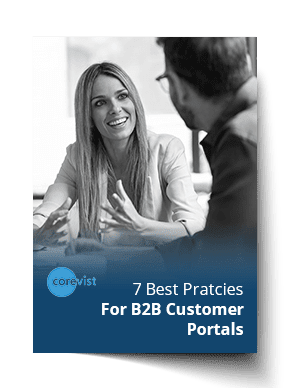Share
Author
George Anderson
Share
First published Oct 7, 2021. Refreshed and expanded Jan 17, 2023.
Manufacturers are finding that a B2B portal is essential to retaining market share in today’s economy. After all, 85% of B2B buyers will ditch a supplier with a bad digital experience (Avionos B2B Buyer Report).
So what makes a great B2B portal for manufacturers?
The solution should give your channel partners a one-stop shop for doing business with you. It should empower them to place orders (or quote requests) online—and it should offer self-service order tracking, invoice visibility, document downloads, digital payments, and more.
Of course, on the internal side, your B2B portal shouldn’t make life harder for IT or customer service.
With that in mind, here are 5 keys to a great B2B portal.
1. Your B2B portal should be easier to use than phone, fax, and email
Whether you already have a B2B portal, or you’re looking to launch one, one thing’s for sure: Customers want an easier way to do business with you.
If you currently rely on phone, fax, and email to take orders (and answer customer service inquiries), then believe us—there’s a better way!
But your B2B portal has to be easier to use than older channels. In other words:
- Your B2B portal needs to work well on any device.
- Your B2B portal should have an intuitive interface that was designed from years of user interaction data.
- Your B2B portal should always show real-time, personalized data to each logged-in customer. This requires a powerful integration to SAP ERP.
That last point is important. Without the right information in the portal, your customers won’t be able complete transactions or tasks.
Let’s unpack that.
2. Your B2B portal should give every customer the right personalized data
Here’s where B2B portals get challenging: If your customers have personalized contract pricing, product availability, SKU permissions, and more in SAP ERP, then you need to create experiences in the portal that reflect that data.
The only way to do this is to integrate your B2B portal with SAP ERP.
FREE whitepaper
7 Best Practices For B2B Customer Portals
Start with a goal of reducing phone, fax, and email inquiries—and put the voice of the customer first. But don’t create more work for IT.
Yet third-party connectors often introduce problems. You’ll have to keep 3 systems working properly (SAP ERP, connector, and B2B portal). It’s easy for configurations to get out of sync. When that happens, a broken integration creates a bad customer experience, as customers can’t get the real-time, personalized data they need.
The alternative is to choose a B2B portal that includes prebuilt, configurable SAP integration. That’s the thinking behind the Corevist Platform, which is built for SAP ECC and S/4HANA.
3. Your B2B portal should reduce your customer service workload
Customer experience is arguably the biggest reason that manufacturers need a B2B portal. Today’s buyers judge companies based on their digital customer experience, and there’s no way around that.
But there are internal drivers for a B2B portal, too. Manufacturers find it’s difficult to scale their market share without scaling up their costs as well. For every customer you add, you’ll need more CSRs (customer service reps) to take orders, communicate about problems, and provide order status updates.
This is where a B2B portal really shines. If the solution includes comprehensive SAP ERP integration, which shows the right data to each customer, it can drastically reduce your customer service burden.
Here are the tasks that manufacturers typically move from CSRs to self-service in a B2B portal:
- Answering questions about order status and shipment status
- Answering questions about invoices and credit status
- Answering questions about product specifications
- Accepting orders from customers
- Processing payments from customers
Taking these tasks off the plate of your CSRs has a huge impact. Believe it or not, Carey L. with Emmerson Packaging reduced customer service workload by 97%. Read Carey’s story here.
4. Your B2B portal shouldn’t create more work for IT
Midmarket manufacturers typically don’t have boundless IT resources. You might have a small team maintaining SAP ERP—and that’s a big job on its own.
If IT is already working at capacity to maintain SAP ERP, then your B2B portal shouldn’t add to their workload. It should leverage the work they’re already doing in SAP.
That’s why a direct, real-time, managed integration to SAP is so important. It empowers you to reuse the value of SAP ERP for customer experience. It’s one of the main reasons that the Corevist Platform includes 49 managed, configurable SAP integration points.
5. Your B2B portal should include the features your customers need
The first question manufacturers should ask is, “What functional areas should we cover in our B2B portal?”
In other words, what capabilities will you give customers in the portal? It’s important to hash out a detailed answer here before you go looking for a solution — because not every B2B portal platform will support the needs of manufacturers’ customers.
Here are the functional areas that manufacturers typically need to cover in a B2B portal.
Tracking capabilities
A B2B portal can drive organizational efficiency in the OTC (order-to-cash) cycle — but only if the portal empowers customers to perform business tasks through self-service. While that typically includes the ability to place online orders (see below), it’s equally important to give customers tracking capabilities within the portal.
For manufacturers, that typically means customers need access to full order history, real-time status and tracking numbers. They also need visibility into invoice status and history — plus real-time credit status.
Since all of this data lives in SAP ERP, manufacturers typically need some form of integration between SAP and their B2B portal. Without that integration, customers won’t be able to track orders and invoices through self-service — which will lead to an increased inquiry burden for the customer service team.
Pricing and inventory check
Sometimes, customers just need to get a quick, real-time check on price and availability for a given product. In this scenario, they don’t want to go through the motions of adding a product to the cart and viewing the cart to get that information.
This is why B2B portal solutions should offer quick price and availability checks in addition to online ordering. This feature empowers your customers to get 100% accurate contract pricing and real-time inventory data in the portal — without picking up the phone.
Here’s what this feature looks like in the Corevist Platform.
Personalized product catalog
For manufacturers that have customer-specific catalogs or picklists, a challenge arises when it comes to B2B portals. How do you ensure that each customer sees only the products they’re allowed to buy?
There are many ways to solve this problem — and most are incredibly complicated and difficult to support.
The most efficient way to provide a personalized catalog experience is to leverage your existing SAP ERP business rules. Whatever product permissions or picklists you’ve defined in SAP, that’s the logic that you want working in your B2B portal. You should look for a solution that leverages that SAP logic in real time to deliver a personalized catalog. (Hint: This is what the Corevist Platform provides.)
Checkout process that honors your business rules
When it comes to the cart and checkout process, you need your SAP ERP business rules enforced here, too. If customers can place orders online for the wrong SKUs at the wrong prices with the wrong RDDs (requested delivery dates), then your B2B portal isn’t going to make you more efficient or easier to do business with. In fact, it’s going to create a bad customer experience and drive up your cost to serve.
Here, again, the key is a comprehensive SAP ERP integration that enforces the relevant SAP logic in every transaction.
Watch how this works in the Corevist Platform.
Online payments supported
Not every manufacturer wants to accept digital payments in the portal. But for those that are ready to transition away from paper-based A/R processes, this is an essential feature.
If customers can view invoices, open items and credit status, they may expect payment capabilities, too. Here, you should look for a solution that can integrate with a payment gateway provider — and one that can post the transaction instantly to SAP.
Integrated analytics
If you’re primarily transitioning existing business to a B2B portal, analytics may not be a high priority. It’s clear that analytics are essential if you’re using your portal as a growth engine, but are they really that important when it comes to existing customers?
Yes!
Whatever your business goals are with the B2B portal, analytics are essential for analyzing user behavior and identifying areas for improvement. A good B2B portal should integrate with a leading third-party analytics platform to provide business intelligence.
Want to learn more about Google Analytics and the Corevist Platform? Check out this post: Run Smarter With B2B eCommerce Analytics.
The takeaway: Put your customers first (and give IT a break)
It all boils down to this: When it comes to B2B portals, manufacturers should put the needs of customers first.
But the key is to do it without making more work for IT.
That’s why manufacturers are finding success with the Corevist Platform. SAP has certified our prebuilt integration for ECC or S/4HANA, and that integration comes with the platform. We host every solution in the cloud and manage, upgrade, and support it. This empowers manufacturers to compete online while maintaining the focus on their core business—rather than investing in technologies that are difficult to support.
FREE whitepaper
7 Best Practices For B2B Customer Portals
Start with a goal of reducing phone, fax, and email inquiries—and put the voice of the customer first. But don’t create more work for IT.










